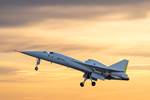Boom Supersonic XB-1 supersonic jet accomplishes third flight
Supersonic demonstrator aircraft has successfully completed its third flight using digitally optimized aerodynamics, carbon fiber composites and advanced supersonic engine intakes.
Source | Boom Supersonic
’s (Denver, Colo., U.S.) supersonic demonstrator aircraft, XB-1, has taken to the skies again to successfully complete its thirdd flight. The flight was piloted by chief test pilot Tristan “Geppetto” Brandenburg at the Mojave Air & Space Port in Mojave, California on Sept. 13, 2024.
During this flight, the team continued to test key systems and performance as they systematically expand the flight envelope. Geppetto took XB-1 to the maximum pitch and yaw attitudes that the company expects to see in flight. This testing was done at a safe, higher altitude to ensure there were no unexpected handling qualities, so as to avoid this happening during a critical phase of flight.
The team also checked the performance of the environmental control system (ECS), which controls the temperature and pressurization of the cockpit. This test is to ensure that the ECS is functioning as designed before XB-1 goes to higher altitudes, where it is colder and the pressure is lower. The landing gear was extended and retracted at higher speeds than its previous flight (215 knots), marking the second of three steps working up to the maximum safe speed for raising and lowering the gear, which is 225 knots. Additionally, the team continued testing of the stability augmentation system, which was demonstrated during the second flight.
The XB-1 flight test program continues to progress, while systematically expanding the flight envelope to confirm its performance and handling qualities, through and beyond Mach 1. According to the company, the sequencing of test flights is set to increase through this next phase of testing, with a total of approximately 10 flights before reaching supersonic speeds.
Following XB-1’s inaugural flight, Boom secured a Special Flight Authorization (SFA) to exceed Mach 1 from the Federal Aviation Administration (FAA). XB-1 test flights are being conducted in the R-2508 Complex, and supersonic operations are occuring in the Black Mountain Supersonic Corridor and in a portion of the Bell X-1 Supersonic Corridor within the R-2515 airspace, which has been used for research and military supersonic aeronautical operations.
XB-1 provides the foundation for the design and development of Overture, Boom’s supersonic airliner. XB-1 leverages enhanced technologies to enable efficient supersonic flight, including digitally optimized aerodynamics, carbon fiber composites, advanced supersonic engine intakes and an augmented reality vision system for takeoff and landing visibility.
Related Content
-
Development of a composite liquid hydrogen tank for commercial aircraft
Netherlands consortium advances cryogenic composites testing, tank designs and manufacturing including AFP, hybrid winding, welding of tank components and integrated SHM and H2 sensors for demonstrators in 2025.
-
Otto Aviation launches Phantom 3500 business jet with all-composite airframe from Leonardo
Promising 60% less fuel burn and 90% less emissions using SAF, the super-laminar flow design with windowless fuselage will be built using RTM in Florida facility with certification slated for 2030.
-
The next-generation single-aisle: Implications for the composites industry
While the world continues to wait for new single-aisle program announcements from Airbus and Boeing, it’s clear composites will play a role in their fabrication. But in what ways, and what capacity?






